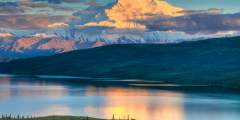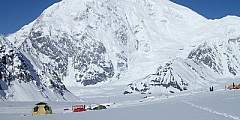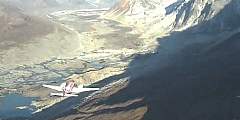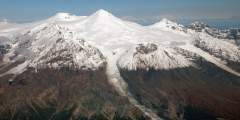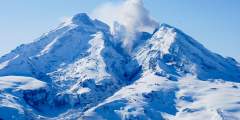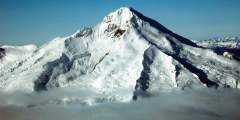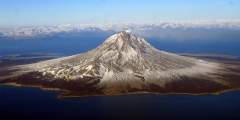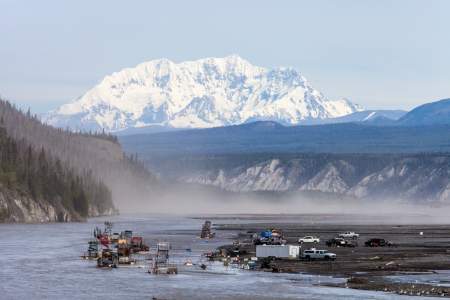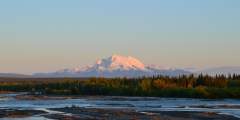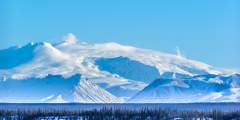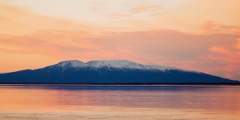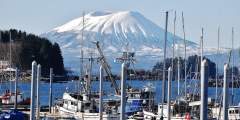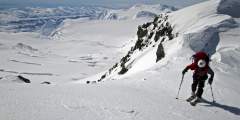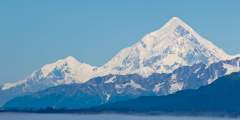A Guide to Alaska’s Grandest Mountains
Immense mountains simply dominate Alaska. They catch the snow that feeds 100,000 glaciers. They generate their own weather. They erupt in colossal explosions. They anchor some of the most spectacular views in the world.
They form a rugged, icebound and all-but impenetrable buttress that rims the Gulf of Alaska, with only four highway gaps along an 800-mile arc from Ketchikan near the southern tip of the Southeast Panhandle to Anchorage and Kenai on Cook Inlet. They include Denali—the tallest peak in North America and one of the largest geographic features on Earth. They include 12 of the 13 tallest peaks in the country—or about one-fifth of the 200 highest summits in North America.
Here are the big ones, the notable white massifs that beg to be photographed and contemplated. They might loom on the horizon up to a hundred miles (or more) away from where you first see them. They can be climbed, to be sure, but those who put boots on their slopes must have expertise or expert guiding (or both.) Most regular visitors admire them from afar, or approach during flightseeing trips.
Show Map
Points of Interest
Alaska Range
Soaring high at 20,310 feet is Denali (formerly named Mt. McKinley after an Ohio Senator who never visited Alaska). The mountain was renamed Denali in 2015. Equally impressive are its nearby cousins: Mt. Foraker (17,400), and Mt. Hunter (14,573). These three dominate the skyline for hundreds of miles. You can get up close and personal with the “Roof of North America” on a flightseeing tour. Up here, you are surrounded by ridges and peaks,… ...more
These mountains lie in the central Alaska Range, roughly 120 miles east of Denali (Mt. McKinley). To the east of the Parks Highway and north of the Denali Highway (the gravel highway that connects Cantwell to Paxson), they are relatively inaccessible and seldom climbed. In this video, we follow pilot Jim of Denali Air into the range and a mountain kindgom equally spectacular to Denali and the mountains to the west – just not as well known. ...more
Cook Inlet Volcanoes
Mount Spurr forms the southern buttress of the Tordrillo Range, with an active vent on Crater Peak below the summit. This 11,070-foot volcano last erupted in September of 1992, when it dusted the region with an eighth-inch layer of volcanic ash and shut down the regular life in Alaska’s largest city for several days.
This 10,197-foot massif about 110 miles southwest of Anchorage and 50 miles west of Kenai is one of the most active volcanoes in Alaska. A 1989 – 90 series of eruptions caused more than $160 million in damages and lost revenue, the second most costly eruption in U.S. history.
Iliamna rises less than 50 miles across the water from two state recreation beaches on the southwest corner of the Kenai Peninsula. Try Deep Creek State Recreation Area at Mile 137, where camping on the beach may be available. (Breakfast with a volcano!) Anchor River State Recreation Area at Mile 157 offers more fabulous viewing.
One of the most restless volcanoes in the region, this stunning 4,134-foot cone forms its own five-mile-diameter island in Cook Inlet about 70 miles west of Homer and 170 miles southwest of Anchorage
Wrangell St. Elias Volcanoes
Alaska’s sixth highest peak, the 16,237-foot Sanford dominates the northwest corner of the Wrangell Mountains. A great view of Sanford (and its sister volcanoes of Drum and Wrangell) fills the windshield during the final 10-mile-drive east into Glennallen on the Glenn Highway.
This 12,011-foot volcano rises only about 37 miles due east of Glennallen in a storybook cone with a snowy crown. Although Drum had a dramatic prehistoric eruption history, scientists believe it has not exploded in about 800,000 years.
This colossal shield volcano may be one of the largest landforms in Alaska — rising 14,163 feet. The summit area features an ice-filled caldera more than 3,000 feet deep. A great view of Wrangell (and its sister volcanoes of Drum and Sanford) fills the windshield during the final 10-mile-drive east into Glennallen on the Glenn Highway.
Other Landmark peaks
Often called “The Sleeping Lady,” if you look to the west, you will see the woman at rest across the inlet. Alaska Native stories say that the lady was engaged to a man who was off to protect their village before they wed. On the day her fiancé left, she promised to wait in the exact spot where he bade farewell. After many nights, she fell into a deep sleep waiting for him. Word came back to the village that the men were killed. Seeing how… ...more
This dormant volcano rises 3,202 feet. Edgecumbe will be unmistakable during clear weather, looming to the west above Sitka Sound as an immense mound, often topped with a crown of snow.

